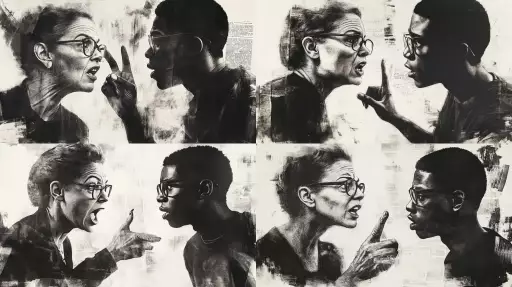Explore the Best AI Image Gallery

AI: The Artists New Palette - Exploring the Impact of AI on Graphic Design
The world of graphic design is undergoing a seismic shift, driven by the rapid advancements in Artificial Intelligence (AI). From generating stunning visuals to automating tedious tasks, AI is reshaping the creative landscape, offering both exciting opportunities and complex challenges. This blog post will delve into the multifaceted impact of AI on graphic design, exploring its potential applications, ethical considerations, and future trends.
The Dawn of AI-Powered Creativity
AI algorithms are now capable of producing high-quality graphics, logos, illustrations, and even web designs. These tools can analyze vast datasets of existing designs, identify patterns and trends, and generate unique visuals that adhere to specific design briefs. This opens up new possibilities for designers, allowing them to:
- Explore unconventional ideas: AI can help designers push creative boundaries by generating unexpected concepts and variations.
- Accelerate the design process: Automating repetitive tasks like resizing images or creating basic layouts frees up designers to focus on more conceptual aspects.
- Personalize designs: AI can generate customized visuals based on user preferences, demographics, or specific brand guidelines.
AI Design Tools: A Glimpse into the Future
Numerous AI-powered design tools are already making waves in the industry:
- DALL-E 2: This powerful tool from OpenAI can generate realistic images from textual descriptions, opening up exciting possibilities for concept art and visual storytelling.
- Midjourney: Accessed through a Discord server, Midjourney allows users to create stunning artwork by simply typing in text prompts. Its ability to generate various art styles has captivated the creative community.
- Adobe Sensei: Integrated into Adobe Creative Suite applications, Sensei leverages AI for tasks like object selection, image enhancement, and even generating personalized design variations.
Ethical Considerations: Navigating the Uncharted Waters
The integration of AI into graphic design raises several ethical considerations that need careful attention:
- Bias in Algorithms: AI algorithms are trained on vast datasets, which can contain inherent biases that reflect societal prejudices. This can result in AI-generated designs perpetuating stereotypes or discrimination.
- Copyright and Ownership: Questions arise regarding the ownership of AI-generated artwork. Who holds the copyright—the AI developer, the user who provided the prompt, or the AI itself?
- Job Displacement: While AI can automate certain tasks, concerns exist about its potential to displace graphic designers, particularly those performing repetitive or entry-level work.
The Future of Graphic Design: A Human-AI Collaboration
Looking ahead, the future of graphic design likely lies in a collaborative partnership between humans and AI. Designers will leverage AI tools to enhance their creativity, streamline workflows, and explore innovative concepts. However, the human element—our ability to conceptualize, empathize, and infuse designs with meaning—will remain irreplaceable.
AI should be viewed as a powerful instrument that empowers designers, not replaces them. By embracing ethical considerations and fostering responsible development, we can harness the potential of AI to elevate graphic design to new heights.
Key Takeaways:
- AI is transforming graphic design by automating tasks, generating creative concepts, and personalizing visuals.
- Ethical considerations regarding bias, copyright, and job displacement require careful attention.
- The future of graphic design lies in a collaborative partnership between humans and AI, where each complements the others strengths.
](https://images.ai-img.art/thumbnails/150/157712d76865d557120f9baf988de3d0525225295a2789c89bf2c4a5a96a03d1.webp)






](https://images.ai-img.art/thumbnails/150/9d51c5e673b4f2068b7b01abc35425a06f173b76303adf9ad29ca14302c25b18.webp)








![**Representation: A dog acting as a private tutor to a child. The dog holds a ruler in its paw and stands at the blackboard to explain a dog diagram to the child. Graphic style: Line drawing, cartoon style, influenced by Franco-Belgian comics, thick black lines, simplified design, vector, black and white only, in the style of Keith Haring or the French comic strip "Alinéa". [IMPORTANT]: A single continuous line extending from one side of the image to the other, minimalist, strong outlines, line drawing, without lifting the hand, ultra-simplified, no shading, entirely white image, drawing created in the center of a sheet of paper. --ar 16:5** - Variations (Strong) by <@627984126871470085> (fast)](https://images.ai-img.art/thumbnails/150/f4e034998ccd869d8a061fd12017514fcd92210eb33d4222dc9b54716223f4dd.webp)
](https://images.ai-img.art/thumbnails/150/51c93500396faff4e7fa8b42bc68033067b16b2230e3496e95c482a581ff0fe9.webp)
![**Representation: A teenager smiling while thinking about a friendly dog, a comic-style thought bubble with a friendly dog inside. Graphic style: Line drawing, cartoon style, influenced by Franco-Belgian comics, thick black lines, simplified design, vector, black and white only, in the style of Keith Haring or the French comic strip "Alinéa". [IMPORTANT]: A single continuous line extending from one side of the image to the other, minimalist, strong outlines, line drawing, without lifting the hand, ultra-simplified, no shading, entirely white image, drawing created in the center of a sheet of paper. --ar 16:5** - <@627984126871470085> (fast)](https://images.ai-img.art/thumbnails/150/6fc850f638e3dee0c4b121acecad2c8419e02bdeac7f871d625f1003c1c3abe1.webp)





















![**Representation: A dog acting as a private tutor to a child. The dog holds a ruler in its paw and stands at the blackboard to explain a dog diagram to the child. Graphic style: Line drawing, cartoon style, influenced by Franco-Belgian comics, thick black lines, simplified design, vector, black and white only, in the style of Keith Haring or the French comic strip "Alinéa". [IMPORTANT]: A single continuous line extending from one side of the image to the other, minimalist, strong outlines, line drawing, without lifting the hand, ultra-simplified, no shading, entirely white image, drawing created in the center of a sheet of paper. --ar 16:5** - <@627984126871470085> (fast)](https://images.ai-img.art/thumbnails/150/7a854648a81e51241dcca8d24dd6e3bfcf07ad1df51baf401c9b729f4cf411fa.webp)



